 |
[2]How to end the game
(The end of the game, confirming borders, filling in the dame points, fixing up false eyes)

· The game ends when both sides have secured their territories. That only thing is that when you have just started playing Go, it may be difficult to judge at what stage the territories have been secured and to what point you have to play to end the game. You have to play a number of actual games to get an understanding of when the game has ended. |
(a) The end of the game
· The borders between the two sides have been settled; neither side can increase his territory by a point, so it is the end of the game. This is hard to grasp for a beginner, but you will immediately understand it when you actually play games, so there's no need to worry.
· Dia. 28 shows a game just about to finish. Please think about the position from White's point of view. How should he play to end the game? |
 |
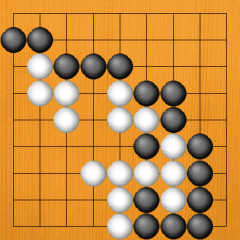
Dia. 28 |
|
Dia. 29. After White 1, Black pushes down at 2 and White blocks at 3, and the game ends. There are no places where either side can increase his territory. There is one black stone inside White's territory, so White removes it and places it inside Black's territory. |
 |
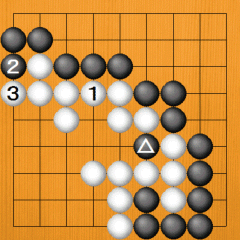
Dia. 29 |
|
Dia. 30 shows the final position. The marked black stone has been placed inside Black's territory, so it is reduced by one. Black has 27 points and White 20 points. |
 |
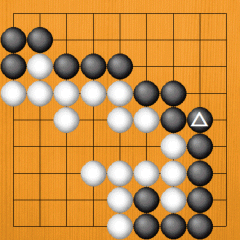
Dia. 30 |
(b) Confirmation of the borders
· Dia. 31 shows another game that's almost finished. Please think about it with Black to play. |
 |
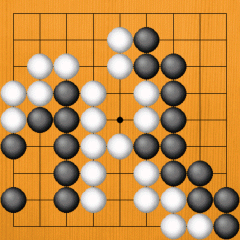
31図 |
|
Dia. 32. First of all, Black settles the position with Black 1 to White 4, then plays the last meaningful moves with 5 and 7 at the bottom. The game is over. |
 |
Dia. 32
|
|
Dia. 33 shows the final position. Please confirm that there's nowhere left to play. |
 |
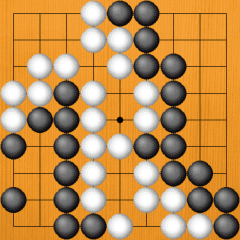
Dia. 33 |
|
Let's look at Dia. 34. With Black to play, please check the borders. |
 |
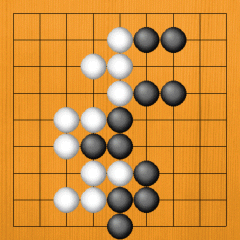
Dia. 34 |
|
Dia. 35. Black plays 1 to 7 in sequence and ends the game. It's not very important whether the order of moves is correct or not. The important thing is to get a feel for how the game ends. |
 |
Dia. 35
|
|
· Dia. 36 shows another game to finish off. It's White's turn. |
 |
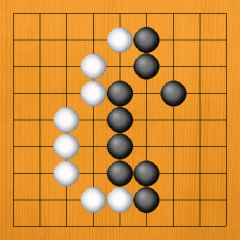
Dia. 36 |
|
Dia. 37. First of all, White settles the bottom area with White 1 to Black 4. |
 |
Dia. 37
|
|
Dia. 38. Next, White settles the top in the same way with 1 to 4. This is not the end of the game. |
 |
Dia. 38
|
|
Dia. 39. Next, the borders are finished off with White 1 to 3. Let's explain why this happens. |
 |
Dia. 39
|
|
Dia. 40. For example, if White doesn't play 3, Black plays 1, putting White on the spot. Even if he flees with 2, Black plays 3 and White is surrounded both vertically and horizontally, so his stones are captured. That's why he had to link up his stones with 3 in Dia. 39. |
 |
Dia. 40
|
|
Dia. 41. The borders have now been decided. Don't you have a query here? What happens with the X points? That's our next theme. |
 |
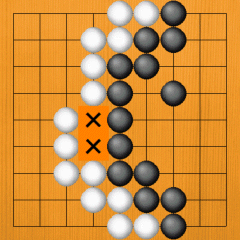
Dia. 41 |
(c) How to fill in the dame points
Let's have another look at Dia. 41. Neither side can make even one point of territory by playing on the X points. Worthless points like this are called dame, a Japanese term that is worth learning. After the borders have been decided, the players take it in turns to fill in these points. The players play Black 1 and White 2 as in Dia. 42. When these vacant points are filled in, the game ends. |
 |
Dia. 42
|
|
Dia. 43 shows another game that's almost finished. With Black to play, please think about how to end the game. |
 |
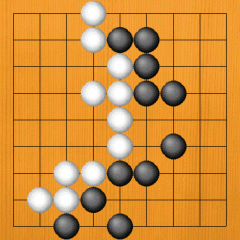
Dia. 43 |
|
Dia. 44. The moves from Black 1 to White 8 are played, and the game is almost finished. |
 |
Dia. 44
|
|
Dia. 45 shows the rest of the game. Black connects at 1, White fills in a dame with 2, and the game is over. In this way, the players fill in all the dame points on the borders between the two sides and the game ends. The reason why Black plays at the point of 1 is connected with the question of false eyes, which we will study next. |
 |
Dia. 45
|
(d) Fixing up false eyes
· There is a phantom point which is not completely territory and which eventually disappears; it's called a 'false eye'. This concept not only refers to territory but is also related to the question of the life and death of groups, which will be treated in our next section. Here we would like to study the problem of how to handle false eyes when making territory.
· Dia. 46. Black and White have each surrounded a territory. Can the X point be counted as territory for Black? |
 |
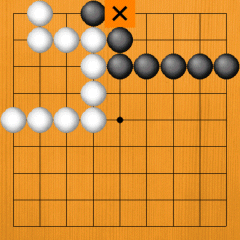
Dia. 46 |
|
Dia. 47. If White plays 1 here, Black must connect at 2, so the point of 2 does not become black territory. |
 |
Dia. 47
|
|
If Black does not play at 2, White can capture a black stone as in Dia. 48. |
 |
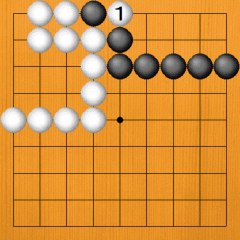
Dia. 48 |
|
· The same applies to the X point here. |
 |
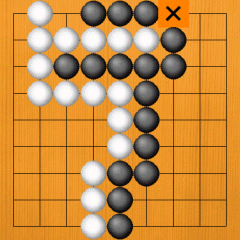
Dia. 49 |
|
Dia. 50. If White plays at 1, Black can't omit the connection of 2, so the X point in Dia. 49 does not become black territory. |
 |
Dia. 50
|
|
· Dia. 51. Please think about the X point here. Is this a dame point that has no meaning for either side? |
 |
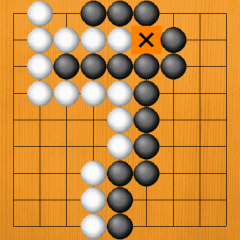
Dia. 51 |
|
Dia. 52. If Black plays at 1, the X point becomes black territory. |
 |
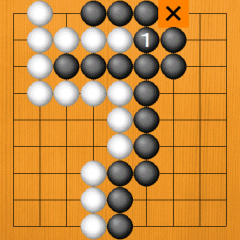
Dia. 52 |
|
Dia. 53. In contrast, if White plays at 1, the X point becomes a false eye, so it doesn't become black territory. This is an endgame problem involving one point of territory. |
 |
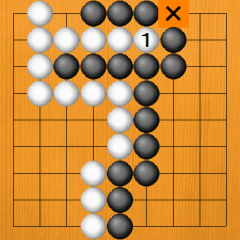
Dia. 53 |
|
· (Application 2) Dia. 54. Please finish this game with White to play. The X point is a false eye, so it doesn't become territory for Black. |
 |
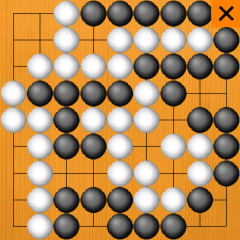
Dia. 54 |
|
Dia. 55. If White plays at 1, Black has to connect at 2, so this is not black territory. Next, if White plays at 3, connecting with Black 4 is essential. White fills the last dame point with 5, and there's nowhere else to play. The game is over. |
 |
Dia. 55
|
· The order of play at the end of the game is as follows.
· First of all, settle the borders --> after fixing up the false eyes --> take turns to fill in the dame points --> when there are no more points to play, the game finishes.
· When they are not sure what to do, it's probably OK for the players to consult each other. You'll get used to this process after some experience, so then you can play more serious games. When you become able to play smoothly to the end of the game, Go becomes a lot more fun, so study and actual playing experience are important. |
|
 |